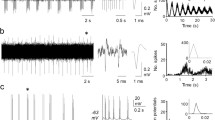Summary
1. Several aspects of the thalamic sensory neurons in man were studied by extracellular recording in the course of stereotaxic intervention in 22 cases.
2. Among 44 sensory neurons studied, 16 responded to light touch on the contralateral small areas (except for one) of the face or the first finger, 6 responded to strong pressure on the contralateral small parts of the face, 15 responded to the passive and active movement of the contralateral joint and 7 responded to contralateral muscle stretch.
3. Although the somatotopic representation in the thalamic area was not so conspicuous it was found that tactile (touch and pressure) neurons were encountered more in the caudal part while the kinesthetic (joint and muscle) neurons were abundant in the rostral part.
4. In nucleus ventralis intermedius region, 2 neurons responded to electrical stimulation of the contralateral median nerve with a fixed latency of about 12 msec.
5. On several occasions, when the sensory neuron was recorded, this same point was electrically stimulated by the same electrode and the patient's experiences thereby caused were asked. Repetitive electrical stimulation at threshold always resulted in paresthesia in exactly the same area of the neuron's receptive field and stronger stimulation provoked sense of electric current in many cases.
6. About one fourth of the total recorded neurons were discharging spontaneously in burst fashion. Principally, these neurons did not respond to any kind of natural stimuli nor could they be influenced by voluntary effort of the patient.
Zusammenfassung
1. Verschiedene Aspekte der sensorischen Neurone des Thalamus wurden am Lebenden mit Hilfe extracellulärer Ableitungen im Verlauf eines stereotaktischen Eingriffes in 22 Fällen untersucht.
2. Von den 44 untersuchten sensorischen Neuronen reagierten 16 (mit einer Ausnahme) auf leichtes Berühren der kontralateralen, eng begrenzten Gebiete des Gesichtes oder des Daumens, 6 reagierten auf starken Druck der kontralateralen kleinen Gebiete des Gesichtes, 15 reagierten auf passives und aktives Bewegen des kontralateralen Gelenkes, und 7 reagierten auf kontralateralen Muskelzug.
3. Obgleich die somatotopische Repräsentation im Gebiet des Thalamus nicht so auffallend war, wurde festgestellt, daß die taktilen Neurone (Berührung und Druck) mehr im caudalen Teil zusammentreffen, während die kinästhetischen (Gelenk und Muskel betreffenden) Neurone im rostralen Teil angehäuft waren.
4. Im Gebiet des Nucleus ventralis intermedius reagierten 2 Neurone auf elektrische Reizung des Nervus medianus der gegenüberliegenden Seite mit einer fest bestehenden Latenzzeit von 12 msec.
5. Bei mehreren Gelegenheiten, während das sensorische Neuron abgeleitet wurde, wurde derselbe Punkt mit Hilfe derselben Elektrode elektrisch gereizt und der Patient nach seinen dabei empfundenen Erfahrungen befragt. Repetierende elektrische Stimulation an der Reizschwelle resultierte immer in einer Paraesthesie in genau demselben Gebiet des dem Neuron zugehörigen Rezeptionsfeldes, stärkere Reizung rief in vielen Fällen ein Elektrisiergefühl hervor.
6. Ungefähr ein Viertel aller registrierten Neurone entluden sich spontan und explosionsartig (burst). Prinzipiell reagierten diese Neurone auf keinen natürlichen Reiz, noch konnten sie durch den Willen des Patienten beeinflußt werden.
Similar content being viewed by others
References
Albe-Fessard, D., Arfel, G., Guiot, G.: Activités électriques caractéristiques de quelques structures cérébrales chez l'homme. Ann. Chir. 17, 1185–1214 (1963).
Bates, J. A. V.: Analysis of unit discharge in the human forebrain during stereotaxic surgery. Proc. IUPS (Munich) 3, 197–198 (1971).
Bertrand, G., Jasper, H. H., Wong, A., Mathews, G.: Microelectrode recording during stereotactic surgery. Clin. Neurosurg. 16, 328–355 (1969).
Derome, P.: Le noyau ventral posterieur chez l'homme. Thèse (Paris) 1965.
Fukamachi, A., Ohye, C., Narabayashi, H.: Delineation of the thalamic nucleus with a microelectrode in the stereotaxic surgery for parkinsonism and cerebral palsy. In preparation.
Gaze, R. M., Gillingham, F. J., Kalyanaraman, S., Porter, R. W., Donaldson, A. A., Donaldson, I. M. L.: Microelectrode recordings from the human thalamus. Brain 87, 691–706 (1964).
Goto, A., Kosaka, K., Kubota, K., Nakamura, R., Narabayashi, H.: Thalamic potentials from muscle afferents in the human. Arch. Neurol. (Chic.) 19, 302–309 (1968).
Guiot, G., Arfel, G., Derome, P., Kahn, A.: Procédés de contrôle neurophysiologique pour la thalamotomie stéréotaxique. Neuro-chirurgie 14, 553–566 (1968).
Hankinson, J., McComas, A. J., Upton, A. R. M., Wilson, P.: Properties of somatosensory cells in the human thalamus. J. Physiol. (Lond.) 216, 23–24 (1971).
Hassler, R.: Anatomy of the thalamus. In: Introduction to stereotaxis with an atlas of the human brain, Vol. I, pp. 230–290, Ed. Schaltenbrand, G., and Bailey, P. Stuttgart: Thieme 1959.
Jasper, H. H., Bertrand, G.: Thalamic units involved in somatic sensation and voluntary and involuntary movements in man. In: The Thalamus, pp. 365–390, Ed. Purpura, D. P., and Yahr, M. D. New York: Columbia University Press 1966.
Mountcastle, V. B., Henneman, E.: The representation of tactile sensibility in the thalamus of the monkey. J. comp. Neurol. 97, 409–440 (1952).
Ohye, C.: Properties of thalamic sensory neurons in man explored by a microelectrode. Electroenceph. clin. Neurophysiol. Soc. Proc. In press.
Ohye, C., Kubota, K., Hongo, T., Nagao, T., Narabayashi, H.: Ventrolateral and subventrolateral thalamic stimulation. Arch. Neurol. (Chic.) 11, 427–434 (1964).
Ohye, C., Narabayashi, H.: Activity of thalamic neurons and their receptive fields in different functional states in man. Exc. Med. Internat. Congress Series. In press.
Poggio, G. F., Mountcastle, V. B.: The functional properties of ventrobasal thalamic neurons studied in unanesthetized monkeys. J. Neurophysiol. 26, 775–806 (1963).
Schaltenbrand, G., Bailey, P. (Ed.): Introduction to stereotaxis with an atlas of human brain, Vol. II. Stuttgart: Thieme 1959.
Tasker, R. R., Emmers, R.: A double somatotopic representation in the human thalamus. Its implication in localization during thalamotomy for parkinson's disease. In: Third Symposium on Parkinson's Disease, pp. 94–100, Ed. Gillingham, F. J., and Donaldson, I. M. L. Edinburgh-London: Livingstone 1969.
Yoshida, M., Yanagisawa, N., Shimazu, H., Givré, A., Narabayashi, H.: Physiological identification of the thalamic nucleus. Arch. Neurol. (Chic.) 11, 435–443 (1964).
Author information
Authors and Affiliations
Rights and permissions
About this article
Cite this article
Ohye, C., Fukamachi, A. & Narabayashi, H. Spontaneous and evoked activity of sensory neurons and their organization in the human thalamus. Z. Neurol. 203, 219–234 (1972). https://doi.org/10.1007/BF00316113
Received:
Issue Date:
DOI: https://doi.org/10.1007/BF00316113



